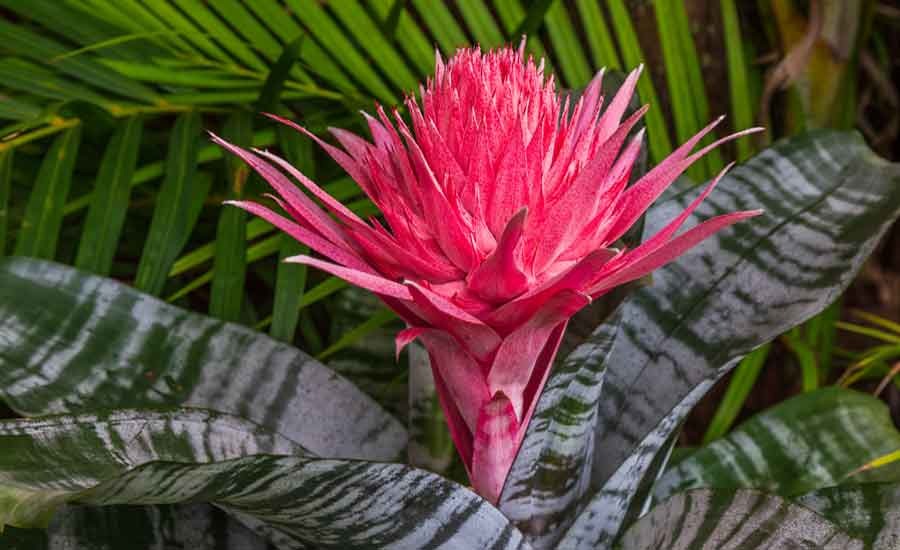Adding plants to a space can make it more vibrant and green. They also create a relaxing atmosphere, decorate the area, and filter the air. The right plants can energize any space, whether a large garden or a small indoor area.
A bromeliad is a tropical plant with bright, colorful leaves and sometimes flowers. It grows in warm places like rainforests and can be found on trees, rocks, or the ground. Bromeliads do not need much soil because their leaves absorb water from the air. People like to keep bromeliads as houseplants because they are easy to care for and look beautiful.
Growcycle offers a complete Bromeliad care guide and all the necessary agricultural tools to grow and manage outdoor plants that help improve the beauty of the landscape.
Botany of Bromeliad Plant
Bromeliads have thick, often colorful leaves that grow circular, forming a central cup that holds water. Their leaves can be smooth or spiky and come in green, red, purple, or yellow shades. Many bromeliads produce bright, long-lasting flowers that grow from the center of the plant.
Bromeliads’ roots mainly anchor them to trees or rocks rather than absorb nutrients. Instead of depending on soil, they absorb water and nutrients through small pores on their leaves. Some even grow without soil, like air plants (Tillandsia), which get everything they need from the air.
Types of Bromeliad Plant
All bromeliads are beautiful, and each type has a unique look. There are many types of bromeliads, but here are some common ones:
- Guzmania: These have soft, green leaves and bright red, yellow, orange, or pink flowers. They are often kept as houseplants.
- Tillandsia (Air Plants): These do not need soil and absorb water from the air. They can grow on trees, rocks, or even hang freely.
- Neoregelia: These have broad, colorful leaves; their centers turn bright red or pink when ready to bloom.
- Aechmea: These are known for their spiky leaves and unique, long-lasting pink or purple flowers.
- Vriesea: It has smooth leaves and tall, colorful flower spikes that look like swords or feathers.
- Ananas (Pineapple): The most famous bromeliad grows the sweet pineapple fruit.
Benefits of Bromeliad Plant
- Bromeliads are among the most beautiful plants. Combining colors, shapes, and patterns can make any space brighter. Their lively flowers and silver-patterned leaves look striking in gardens or homes.
- Unlike many other plants, these tropical beauties maintain flowers for months, bringing color and freshness with them. They are ideal for busy plant lovers because they require little care and can tolerate neglect.
- These plants tolerate dry spells and recover even if water supply is reduced because they have tiny trichomes that allow them to absorb moisture. They can withstand drought because their rosette of leaves gathers and retains water. Water the central cup rather than the soil to keep them thrilled.
- Bromeliads look fantastic and help purify the air by removing harmful volatile organic compounds (VOCs) from paint and printers. Growing bromeliads is a stress-relieving and peaceful gardening hobby.
- Because of their adaptability, bromeliads look stunning in terrariums and bring bright color to small areas. Their colorful flowers attract butterflies and birds, improving the garden’s aesthetic appeal and promoting local wildlife.
Bromeliad Plant Care
Here are some key tips to keep the Bromeliad healthy and thriving:
1. Light
Bromeliads are rare plants that thrive in bright light and can survive in various environments. They need a lot of light to remain healthy, whether indoors or outdoors. Although they can withstand some shade, their leaves may turn green and lose their vivid orange and red shades if they receive insufficient bright light. Ensuring they get adequate light during the summer, when their growth is most rapid, is crucial.
2. Soil
Unlike most houseplants, bromeliads do not require regular repotting. They like potting mixes that drain well, like the soil in tropical rainforests. Orchid bark, cymbidium orchid mix, or a unique bromeliad mix are examples of an appropriate blend. In addition to giving the roots nutrients, this light mixture keeps the soil from getting too wet, which could cause harmful bacteria or root rot.
3. Water
The water requirements of bromeliad plants are unusual. Most of their moisture is absorbed by their leaves compared to their roots. They frequently grow on trees in the wild, storing and collecting water with rosette-shaped leaves.
When caring for these plants indoors, keep the water reservoir full, but never leave the water standing for too long, as this can contain dangerous bacteria. Rainwater or purified water is preferable to tap water, which may contain chemicals and minerals harmful to plants. Misting the leaves with water can raise the humidity level around the plant in hot, dry weather.
4. Temperature and Humidity
The ideal bromeliad temperature range is between 70°F and 90°F, similar to summer temperatures. However, they may have difficulties when the temperature falls below 50° F. These tropical plants prefer a humid environment, and dry indoor air can be challenging.
A tank or tray filled with water and stones can increase humidity around the plants. Misting the leaves regularly and adding damp moss can also help, but it is essential to monitor moisture levels. Excess moisture can lead to problems with pests and bacteria.
5. Fertilizer
Bromeliads can absorb water and nutrients from the atmosphere because of their fantastic rosette shape and low nutrient requirements. Use a balanced fertilizer or one made especially for bromeliads during the summer, when these plants grow the most, but keep it light.
6. Pruning
These plants are simple to prune. The main plant begins to fall after it has finished flowering. At this point, gardeners can carefully cut off the center rosette with a clean, sharp tool while keeping the newborns around it safe. Eventually, their offspring will develop into mature bromeliads.
FAQs
How long does a bromeliad live?
Growing new plants from the bromeliad’s pups can extend its lifespan by two to five years.
Can a bromeliad be grown outside?
Yes, it can be grown in a warm climate. They grow well in gardens or attached to trees in tropical or subtropical areas.
Do bromeliads bloom?
Yes, but only once in their lifetime. The flowers last for weeks or months; the plant produces small “pups” (baby plants) after blooming.
The Bottom Line
The bromeliad plant is a common choice for home gardens because it adds greenery and health to the house. It improves the appearance of any area, lowers stress, improves mood and mental health, and purifies the air. Gardeners can grow bromeliads using division or stem propagation. However, to thrive, these plants require proper maintenance. Visit Growcycle to explore and grow the bromeliad plant to make indoor and outdoor spaces beautiful.

